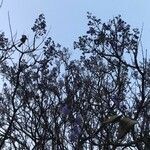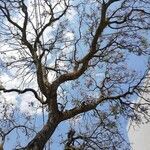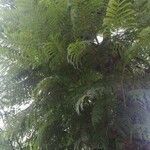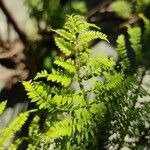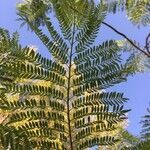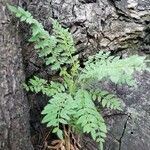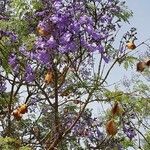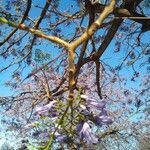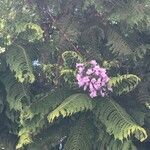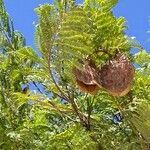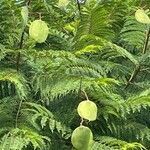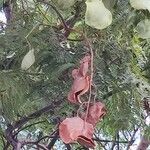Tree to at least 15 m tall and 45 cm dbh., the bark gray, the branchlets terete. Leaves bipinnate, 15-30 cm long, with 13-31 pinnae, these 1.3-2.1 cm apart on the rachis, each pinna 5-10 cm long with subwinged rachis and 13-41 sessile leaflets, these 3-12 mm long and 1-4 mm wide, narrowly elliptic, sharply acuminate, the base cuneate, chartaceous, glabrous or slightly puberulous along midrib and margin, the margin slightly revolute. Inflorescence an open terminal panicle, the branches shortly puberulous. Flowers with the calyx reduced, broadly campanulate, 5-denticulate, 1 mm long, 1.5-2 mm wide, subpuberulous at least along margin; corolla purplish-blue with the tube white inside, tubular-campanulate above a slightly narrowed neck which is conspicuously curved and slightly enlarged toward base, 3-4 cm long, 0.7-1.2 cm wide at mouth of tube, the tube 2.4-5.2 cm long, the lobes 0.3-0.8 cm long, pubescent outside, especially toward the base, pubescent inside at the level of stamen insertion and sparsely so with long trichomes in the tube; stamens didynamous, monothecate, the second theca reduced to a minute appendage, each theca 2 mm long, the filaments pubescent below middle, the staminode 2-2.5 cm long, glandular-pubescent at middle and apex; pistil 2.2-2.5 cm long, the ovary flattened-cylindrical, 2-3.5 mm long, 1.5-2 mm wide, glabrous, the ovules 6-8-seriate in each locule; disk short, pulvinate. Fruit a compressed-orbicular capsule, often shallowly emarginate at the tip and truncate to broadly but shallowly subcordate basally, 3.2-6 cm long, 3.7-6 cm wide, drying brownish or tannish, the margins not or very slightly undulate; seeds thin, 0.9-1.2 cm long, 1.1-1.7 cm wide, the wing more or less surrounding and clearly demarcated from seed body, hyaline-membranaceous with brownish streaks.
Tree to 15 m (–20) high, deciduous in early spring. Leaves opposite, bipinnate, (11–) 15–40 (–51) cm long; pinnae (6–) 10–20 (–25) pairs, (2.5–) 5–10 (–14) cm long, opposite or subopposite; pinnules (6–) 12–24 (–28) pairs and a terminal pinnule (often lost on dried specimens), narrowly elliptic or narrowly elliptic-oblong (terminal pinnule often lanceolate), 3–12 (–15) mm long, 1–4 mm wide, thin, paler below, sessile, apex acute to acuminate, margin slightly revolute; petiole to c. 6 cm long, swollen at base. Inflorescence a terminal panicle, calyx narrow-campanulate, corolla tubular-campanulate, blue-purple with a whitish throat, pubescent on the outside, 2–5 cm long, to 2 cm wide. Fruit a woody, orbicular or ovate-oblong compressed, red-brown capsule, to 8 cm long/wide, splitting in two, apex with a mucronate point; seeds surrounded with a membranous wing.
Tree, up to 22 m high; deciduous or semi-deciduous, round spreading crown. Leaves fern-like, bipinnate, dark green turning yellow in autumn or winter, pubescent. Flowers in loose pyramidal sprays, carried on end of leafless branchlets; mauvish blue, rarely white. Corolla tubular-campanulate above narrow base. Flowering time Sept.-Nov. Fruit a woody capsule, broadly oval, flattened, green turning brown, splits open after ± a year. Seeds flat, winged.
Tree, up to 15 m high. Leaves opposite, with 12 or more pinnae, fern-like. Fruit a roundish, compressed capsule. Flowers blue or violet, rarely white.
